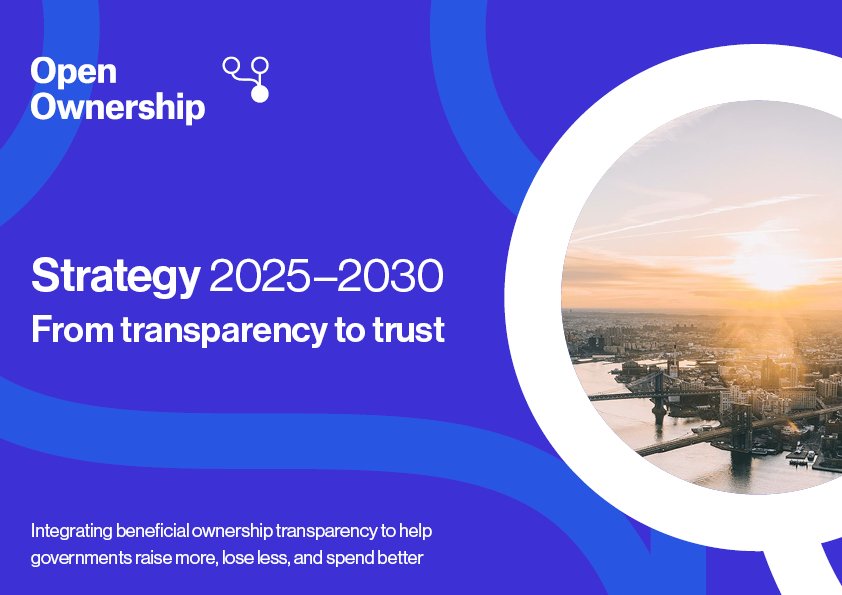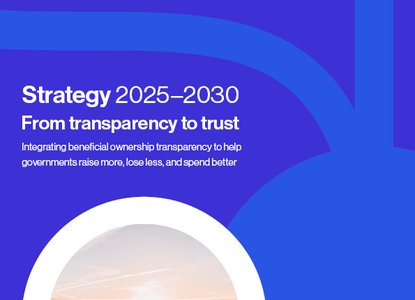From transparency to trust: Our strategy for 2025 to 2030

Ten years ago, if you had asked a room of finance ministers, tax officials or procurement leads about beneficial ownership transparency (BOT), you’d have been met with quite a few confused looks. Today, almost 100 countries have live registers in place to collect data on who really owns and controls companies. And the international consensus is clear: shining a light on hidden ownership is key to fighting corruption and illicit finance.
But for all that progress, the real potential of this reform is still only just being tapped.
At Open Ownership (OO), we’ve spent the past nine months developing our new 2025–2030 strategy. We’ve spoken to partners, analysed what’s worked, and looked ahead to what’s next. Our conclusion is simple: the next phase must be about helping governments use this data to raise more, lose less, and spend better.
Experience has shown that while transparency is a necessary condition, it alone is insufficient to achieve meaningful, accountable governance – this is where data availability, quality, and effective data use are crucial.
A foundation has been laid
When we established Open Ownership back in 2016, only a handful of countries had a live central beneficial ownership register. We helped build the world’s first open data standard for beneficial ownership information, supported dozens of countries to create central registers, and helped establish BOT at the heart of global anti-corruption efforts. Since 2022 alone, we’ve supported reforms in nearly 40 jurisdictions and helped 15 countries launch new registers.
We’ve trained over 2,000 people across government, civil society, and business. Our tools and standards are now being used in over 60 countries. These aren’t just examples of impact. They’re blueprints.
Moving from collection to use
We know the risks of treating BOT reform as a box-ticking exercise. Too many governments have stopped at setting up a register – without verifying the data, or helping people and agencies make use of it. As a result, critical information may sit idle, even as countries struggle with revenue shortfalls, procurement fraud, and public frustration over corruption.
Our new strategy sets out an ambitious course. By 2030, our goal is for beneficial ownership data to be embedded into the day-to-day workings of government. That means integrating it with tax systems, procurement workflows, and criminal investigations. It means focusing on user needs – from customs officials to licensing boards – and helping governments put data to work.
We’ve set clear goals. To get there, we’re focusing on five core priorities:
1. Supporting user-centred, impactful reforms
Having a register is not enough. Over the next five years, OO will focus on helping governments design and deliver beneficial ownership reforms that work for real users – from tax officials and procurement officers to civil society and journalists. That means getting the right laws in place and supporting good digital systems to ensure people can access and use the data to deliver results.
- By 2030, at least 10 countries will have implemented user-centred BOT reforms with our support – and our tools will be used far more widely.
2. Making beneficial ownership data accessible, usable, and connected
Too much data still sits in silos. We’ll work with governments to make ownership information more accessible, better structured, and easier to connect with other datasets – including across borders. That means investing in legal, technical, and operational frameworks that turn data into action.
- By 2030, we’ll have helped at least six governments improve access to domestic and international beneficial ownership data – and made real progress on building the systems that support secure cross-border use.
3. Embedding beneficial ownership data in key areas of public finance
Beneficial ownership data can be a powerful tool for improving procurement, tax collection, licensing, and anti-corruption enforcement. We’ll work with partners to integrate it directly into the systems and workflows that matter – and ensure reforms are hardwired into how governments operate.
- By 2030, at least six countries will be actively using beneficial ownership data in procurement, tax, or licensing – not just maintaining registers, but using them.
4. Building the evidence base
We know BOT works – but we need to show how, and where, it delivers the biggest impact. That means investing in research, measurement, and case studies that demonstrate results and help shape future reforms.
- By 2030, we’ll publish at least 10 new evidence pieces or case studies that show how beneficial ownership data is improving public financial management, reducing illicit financial flows, or delivering other real-world outcomes.
5. Driving global standards and cooperation
From sanctions evasion to illicit flows, many of the biggest risks are transnational. We’ll continue shaping international standards, supporting regional coordination, and advocating for ownership transparency to be embedded in global governance frameworks.
- By 2030, beneficial ownership reforms and data use will be recognised in at least three major global or regional frameworks – helping scale progress far beyond our own direct work.
This strategy sets out where we’re headed. But we won’t get there alone. None of this work would be possible without the collaboration, insight, and support of our partners, peers, and funders around the world. We’re proud of what we’ve achieved together – and excited to keep building, learning, and pushing forward in the years ahead.
Publication type
News article
Sections
Impact
